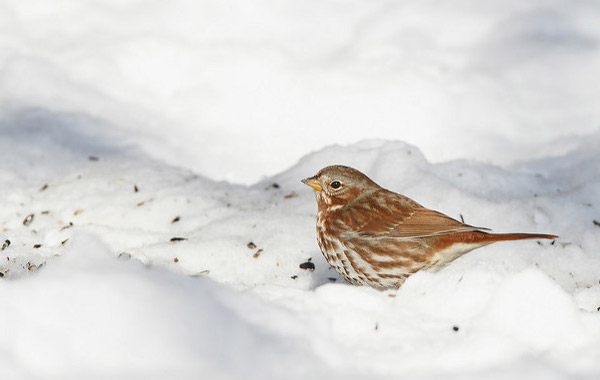Documenting Unusual Birds

Please document unusual birds that appear during the Backyard Winter Bird Survey. Your data becomes part of the permanent record of New Hampshire bird sightings which is a valuable historic resource. Rarities are always subject to scrutiny by future researchers and are most valuable when they are supported by adequate documentation. Photographs are also helpful.
There are no hard and fast rules but you should review any species not listed on the data card that you write in. Not all of these will need documentation — species like the Pileated Woodpecker, American Robin, or Wild Turkey are regularly seen in the winter and easily identifiable. But others are rare in the winter or easily confused with a similar, more common species.
For example, the Pine Warbler is very rare in winter and could be confused with an American Goldfinch. Some species are common in one area of the state but rare in another. A Boreal Chickadee, common in northernmost New Hampshire would need documentation if seen in the southern part of the state. Other species often reported that should have documentation include Cooper’s Hawk, Chipping Sparrow, Eastern Phoebe, Eastern Towhee, Fox Sparrow, Merlin, and Rose-breasted Grosbeak.
To document your unusual bird, please write down a description of the bird, including the size (compared to other birds), pattern and color of the breast and back, length of tail, and bill size and shape. It is not helpful to state that is looks “just like the picture in the book.” Instead, tell us what you saw and why you decided it was not a similar, more common, bird. Notes on the behavior can also help. Include all this information, and a photo if you have one, with your survey form.
Examples of Good Documentation
Below are examples of good descriptions that document an unusual species from Backyard Winter Bird Survey participants.
Northern Shrike
Description: “The Northern Shrike was quite distinctive…smaller than a Blue Jay and more rounded shape (like a robin). Heavy, hooked bill, dark streak (mask-like) from the eye back, and dark tail and wings. But, its actions really confirmed – I watched it chase chickadees for 45 minutes – no other birds ventured to the feeder except for a Blue Jay who seemed unconcerned.” —Alice Custard, W. Ossipee
Comments: The description includes shape, size, and important field marks such as hooked bill and dark face mask that help differentiate it from the Northern Mockingbird – the more common species that is most likely to be confused with Northern Shrike. In this case, the behavior is also helpful for identification because the shrike eats smaller birds while the mockingbird feeds primarily on fruit and insects.
Carolina Wren
Description: “Chickadee size, but rounder with long, upturned tail. Cinnamon back with beige breast, off white streak above eye, dark eyes, tan legs. Feeds at suet/seed ball every day.” —Marilyn Blight, Hanover
Comments: The description of size and shape with the upturned tail is a classic wren. The color of the back, tail length and white eye line eliminate the House and Winter Wrens which are rare in winter. A description of the bill (long and pointed) would have been helpful to rule out sparrows (short, fat bill), but the feeding behavior helps eliminate sparrows which usually feed on the ground.
Fox Sparrow
Description: “Large sparrow, gray and cinnamon brown above – eye and side of head gray, underside white with heavy brown spots. Hops on ground to scratch for food.” —Rebecca Cummings, Nottingham
Comments: The size and description of behavior helps to confirm it as a sparrow (The Brown Thrasher, which is not a sparrow but has the similar cinnamon color is rarer than the Fox Sparrow in winter and is much larger). The cinnamon color of the Fox Sparrow is quite distinctive and the combination with the gray is unique. It helps to eliminate the Song Sparrow which is a common sparrow with spots on the breast that might be confused with Fox Sparrow. The heavy spotting on the breast distinguishes the Fox Sparrow from a House Sparrow which also has rusty and gray color on the face. The Hermit Thrush which is a rare winter lingerer also has a cinnamon tail and spotted breast but lacks the gray and does not scratch for food like a sparrow.